Against this backdrop, Design Thinking (DT) has proven to be a valuable concept to foster creativity, a reason why business schools worldwide have introduced DT and related innovation and entrepreneurship courses to equip the future workforce with the needed soft skills and practical experiences in projects. However, as the application and execution of DT relies, among other factors, on creativity, empathy, intense collaboration, and tangible prototyping to unfold its full potential, the disruption of face-to-face collaboration and today’s demand for new e-learning concepts poses a great challenge. Applying audio- and video-conferencing over a longer period leads to exhaustion and decreased attention due to the high efforts of cognitive load. Nevertheless, the more recent Media Synchronicity Theory (MST) argues that Computer Mediated Collaboration (CMC) can even enhance the quality of communication in comparison to face-to-face settings, when a system applies appropriate channels that support the required speed of communication in the specific setting. Hence, conducting virtual DT is possible and has the potential to reach similar results as when applying it in face-to-face settings.
The key question for higher education is how to foster students` creative capacities in a virtual learning and pedagogical environment? By recognizing that DT is an appropriate tool to convey creativity and by acknowledging the fact that it can be effectively performed in a virtual setting, the question is how these puzzle pieces can be combined to design an adequate learning environment. How to design the technological environment in an appropriate way? What are applicable methods to train creativity in a virtual setting? What is the best way to teach and learn creativity?
This project aims at answering these questions and to develop a universally applicable concept (incl. technology, methods, teaching/learning concepts) to foster creativity in a virtual setting in higher education, in close collaboration between the Technische Universität (TU) Braunschweig, the Center for Entrepreneurship at University of Agder in Norway, and Jacobs University Bremen (JUB).
In order to achieve these goals, this project relies on the philosophy of DT, which inherently combines multiple aspects of Project-based learning (PrBL), Team-based learning (TBL), and Problem-based learning (PBL). The project´s innovative approach comprises four phases:
- Conceptualization of a virtual DT environment (technology and learning approach) for conveying creativity in higher education, in which students learn about creativity methods, processes, and mindsets, and will apply the learned aspects in real-world challenges provided by local business partners.
- Implementation, testing and iteration/refinement of the technical environment and the teaching approach, is intended to take place in courses and modules at the three involved universities. In this phase, an instructional teaching approach will be set up, where trained instructors show students how DT is performed (process, methods, and mindset). Students will then apply DT in real-world projects, dealing with real-world problems formulated by institutions (companies, non-profit organizations, municipality, etc.) to strengthen the relationship to the local communities in Bremen, Braunschweig, and in Kristiansand, Norway, seeking to connect students with potentials employers and collect real world experience.
- Testing, evaluation and improvement – Based on the tests and assessments, the initial technical and didactical concepts will constantly be improved. At a later stage, the didactical concept will be revised by switching from an instructional to a socialization setting, where students train each other and instructors act as coaches to mediate the creativity process, assuming that, at this point in time, methods and tools for imparting creativity and collaboration are appropriately set up.
- Finally, a handbook with a toolkit (process, methods, and curriculum) and hands-on suggestions for teaching creativity in various contexts will be developed. This guarantees a broad dissemination of the knowledge and the application of the new methods, tools and concepts in various different curricular contexts. The involvement of these three different universities will guarantee a broad effect in terms of internationality and interdisciplinarity of the findings.




 Pia Gebbing
Pia Gebbing